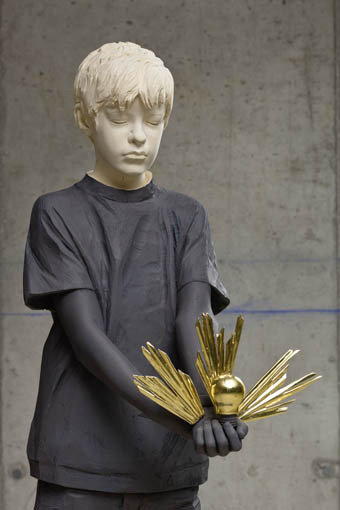Willy Verginer
dal 30/9/2011 al 2/12/2011
Segnalato da
30/9/2011
Willy Verginer
Arte Boccanera, Trento
In hoc signo. In esposizione otto sculture lignee lavorate a tutto tondo. Verginer realizza personaggi ad altezza naturale che non presentano connotazioni specifiche ma vivono in una sorta di dimensione astratta.

----------------english below
a cura di Luigi Meneghelli
Otto sculture lignee, lavorate a tutto tondo, a tutto rilievo, che si ergono con le loro masse e i loro volumi, con il peso della loro
materia nello spazio in cui sono collocate. Otto forme che in molti casi sembrano concentrate su di sè e sul proprio sistema interno di relazioni formali e di significati, come nella tradizione della grande statuaria antica e moderna. Ma la manualità decisa, anzi la lotta serrata con cui Willy Verginer (Bressanone, 1957) provoca o accarezza il legno non consegue un che di arcaico o di ieratico: egli non fa statue, totem o menhir, ma immagini in azione, in cui affiorano ancora i segni della sgorbia, della pialla, della raspa: “tutti attrezzi dai nomi così duri e corti che chi ha buon occhio li sente ancora lavorare" (G. Bachelard).
I suoi personaggi, sempre ad altezza naturale, non hanno riconoscibilità, connotazioni, ma vivono in una sorta di dimensione
astratta. Eretti senza essere monumentali, sublimi senza essere eroici. Per attirare l'attenzione su di sè, essi non hanno a disposizione che le loro pose: gesti minimi, al limite del banale e dell'insignificante, ma anche gesti che fanno degli sforzi estremi per esprimersi, per comunicare oltre la loro fisicità. Essi trasportano la scultura su un altro piano di realtà: sono solidi che come la terra trovano il loro moto, la loro vita nell'atmosfera che gli gira attorno. Tanto che ogni figura è una e molteplice, singola e irradiata oltre i propri limiti, quasi a costituire una sorta di magica installazione. E ad accentuare questo senso di dilatazione, di protensione visiva intervengono anche gli sguardi dei personaggi che scrutano unicamente il vuoto: anzi quella che potrebbe essere una cecità, una visività negata, sviluppa le potenzialità implicite, il racconto che ogni immagine porta in sè.
E poi c'è l'azzardo della pittura: anche il colore infatti non blocca la narrazione ma la sovverte, non caratterizza volti, corpi, vestiti, ma zone, aree, quasi a voler suggerire inattese analogie, impreviste simmetrie spaziali. In questa mostra Verginer riduce il proprio prontuario cromatico alla nudità del legno e alla velatura del grigio-viola, cioè al confronto tra la luce e l'ombra, tra l'occultamento e la rivelazione. Solo che le parti si scambiano continuamente di posto: la tenebra fa aggallare la luce e la luce si ammanta di oscurità. Quale il confine? Quale il segreto del legno (o meglio della “figura di legno”)? Qual è il vero spazio-tempo di questi corpi illusivi? Quale il loro Segno? (Luigi Meneghelli)
-----------english
Eight wooden sculptures in full relief and worked in the round; they rise up with all their mass and volume, with all the weight of their material in the space they are placed in. Eight forms that in many cases seem concerned only with themselves and their own internal system of formal relationships and meanings, fully in the ancient and modern statuary tradition. But the sharp and embattled handling with which Willy Verginer (Bressanone, 1957) provokes and caresses wood does not result in anything archaic or hieratic: he does not make statues, totems or menhirs but images in action; they clearly show the work of the gouge, the plane, and the rasp: "all tools with short, hard names that, to those with a good eye, still seem to be in action" (G. Bachelard).
His human-scale persons have no connotations for recognition but live in a kind of abstract dimension. They stand erect without being monumental, they are sublime without being heroic. In order to draw attention to themselves they only have their pose to help them: minimal, almost banal and insignificant, gestures, but gestures that give their utmost to express themselves, to communicate more than their physical presence. They bring these sculptures to another level of reality: they are as solid as the earth and find their drive and their life in the atmosphere that surrounds them. So much so that each figure is both
one and many, single yet spread beyond its boundaries, almost as though to create a magical installation. And what underlines this sense of dilatation and visual extension are the gazes of these personages which only scrutinize emptiness: what might seem blindness, the denial of vision, in fact develops implicit potentials, the tales that each image bears within itself.
And then there is the hazard of paint: yet even the colour does not block the narration but subverts it; it does not characterize faces, bodies, and clothes but zones, areas, almost as though to suggest unexpected analogies, unforeseen spatial symmetries. In this show Verginer reduces his range of colours to the nudity of wood and to grey-violet veiling ; in other words, there is a confrontation between light and shade, hiding and revelation. Only the parts continually exchange places: darkness allows light to float and light cloaks the darkness. What is the boundary? What is the secret of wood (or rather, of the "wooden figure")? What is the real time-space of these elusive bodies? What is their Sign? (Luigi Meneghelli)
Inaugurazione: Sabato 1 Ottobre 2011
Arte Boccanera Gallery
via Milano 128/130 Trento
Orario: dal martedì al sabato 10.00-13.00 e 16.00-19.00
Ingresso libero



